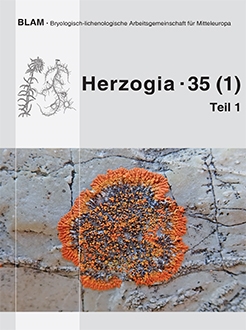Darmostuk, V., Fačkovcová, Z., Breidy, J., Dokmak, H., van den Boom, P. P. G. & Guttová, A. 2022. Solenopsora species as hosts of lichenicolous fungi. – Herzogia 35: 115 –130.
We examined the thalli of members of the lichen genus Solenopsora (Leprocaulaceae) to learn more about their potential to host symptomatic lichenicolous fungi. Altogether, 600 specimens were screened, out of which 78 were infected by lichenicolous fungi. We identified eleven taxa of lichenicolous fungi – Arthonia sp., Ceratobasidium bulbillifaciens, Cladosporium sp., Didymocyrtis cladoniicola, Lichenosticta sp., Merismatium cf. peregrinum, Muellerella lichenicola, Muellerella triseptata, Sphaerellothecium griseae, Stigmidium solenopsoricola, and Zwackhiomyces solenopsorae, out of which S. griseae and S. solenopsoricola are described here new for science. The ratio infected specimens/total inspected host specimens (LF/host ratio) is 0.13 for all examined samples. The highest value of LF/host ratio was recorded for Solenopsora grisea and S. holophaea, respectively (0.35 and 0.30). The greatest diversity of lichenicolous fungi was denoted for Solenopsora candicans and S. grisea. The most frequent lichenicolous fungus on S. candicans was Muellerella lichenicola (85 % of infected host specimens) and Sphaerellothecium griseae (23 % of infected host specimens) on S. grisea. Morphological features and taxonomical remarks on the examined specimens are given.
Darmostuk, V., Fačkovcová, Z., Breidy, J., Dokmak, H., van den Boom, P. P. G. & Guttová, A. 2022. Solenopsora-Arten als Wirte flechtenbewohnender Pilze. – Herzogia 35: 115 –130.
Wir untersuchten die Thalli von Arten der Flechtengattung Solenopsora (Leprocaulaceae), um mehr über ihr Potenzial als Wirte symptomatischer flechtenbewohnender Pilze zu erfahren. Insgesamt wurden 600 Proben betrachtet, von denen 78 mit flechtenbewohnenden Pilzen infiziert waren. Wir stellten elf Taxa flechtenbewohnender Pilze fest – Arthonia sp., Ceratobasidium bulbillifaciens, Cladosporium sp., Didymocyrtis cladoniicola, Lichenosticta sp., Merismatium cf. peregrinum, Muellerella lichenicola, Muellerella triseptata, Sphaerellothecium griseae, Stigmidium solenopsoricola und Zwackhiomyces solenopsorae, von denen S. griseae und S. solenopsoricola hier als neue Arten beschrieben werden. Das Verhältnis infizierter Proben zur Gesamtprobenmenge (LF/host ratio) beträgt 0,13 für alle betrachteten Proben. Der höchste Wert der LF/host ratio wurde für Solenopsora grisea und S. holophaea gefunden (0,35 bzw. 0,30). Die höchste Diversität flechtenbewohnender Pilze zeigten Solenopsora candicans und S. grisea. Der häufigste flechtenbewohnende Pilz auf S. candicans war Muellerella lichenicola (85 % der infizierten Wirts-Proben) und Sphaerellothecium griseae auf S. grisea (23 % der infizierten Wirts-Proben). Morphologische Merkmale der untersuchten Proben werden beschrieben und taxonomische Bemerkungen gemacht.





